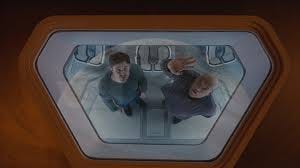Making a film in which the central character is constantly questioning the reality of everything going on around him is easy enough to accomplish in theory. To create a good one, however, the filmmakers have to figure out a way to make us care about that character as they struggle to figure out what is going on as the weirdness unfolds around them—otherwise, it becomes virtually impossible to develop any real interest in what is happening to them and the film just becomes an empty exercise in screwing around with both the character and those watching in the audience. Slingshot starts off as an interesting character study but as things progress, it loses its human element and becomes such an extended display of pulling the rug out from under everyone’s feet that you half-expect that the final shot will be of the spokesman from Empire Carpets chuckling “Ain’t I a stinker?”
In the semi-near future, the space administration plans an ambitious mission to Titan, the largest of Saturn’s moons, to bring back the liquid methane said to be on the surface in order to use it as a fuel source. To have any chance of getting there, the three-man crew—mission commander Franks (Laurence Fishburne), engineer John (Casey Affleck) and numbers analyst Nash (Tomer Capone)—will have to employ the titular procedure to use Jupiter’s immense gravitational pull to accelerate them towards Titan (see Interstellar for a better explanation of the process—hell, just see Interstellar period) and they will each have to undergo multiple rounds of resource-conserving hibernation via drugs that, as the ship’s computer constantly reminds them, list grogginess, hallucinations and memory loss among the side effects.
To put it mildly, there are a lot of questions that could be asked about the practicality of such a mission but before anyone can start doing that, things start going haywire (has there ever been a movie about a deep space mission where everything went smoothly along the way?) when the ship incurs some damage during the pre-slingshot stage that mysteriously cannot be detected by any of the computers. This leads to a schism between Franks, who is determined to carry on with the mission, and Nash, who thinks that slingshotting with a damaged craft is suicide and that they should head home. As for John, a self-professed loner, the hibernation drugs are clearly doing a number on him as he becomes consumed with memories of Zoe (Emily Beechum), the love he left behind on Earth who also happened to be one of the ship’s designers, to the point where he begins seeing her on the ship itself. This obviously cannot be and it leaves John wondering if anything that is happening is real or if it is all one big hallucination.
Slingshot was directed by Mikael Hafstrom, whose previous credits include 1408, an excellent and somewhat underrated adaptation of a Stephen King short story that also dealt with one person stuck in an environment (a supposedly haunted hotel room) that forced him to question the reality of everything that he was seeing, feeling and experiencing. That film worked because even though the premise was fantastical, it took time to establish that character so that when all the strange stuff began to happen, we actually gave a shit about what was happening and what he was (or thought he was) experiencing. By comparison, the screenplay by R. Scott Adams and Nathan C. Parker is a disjointed contraption that tries juggling a lot of material during its first half—the details of the mission, the increasingly tense conflict between Franks and Nash over how the mission should proceed and John’s struggles to process both his drug-induced hallucinations and paranoia and his memories of his relationship with Zoe. For the second half, however, most of these ideas are abandoned as one bizarre plot development after another is introduced into the mix that steers it away from being a mildly interesting character study into a not-so-interesting puzzle with a conclusion that is meant to blow the minds of viewers but which is likely to leave most of them annoyed rather than enthralled.
Slingshot does have a few interesting ideas upfront and the performances by Fishburne, Capone and Affleck are as good as one could hope—the film makes effective use of the extremely laid-back persona that Affleck has demonstrated in other films. At a certain point, though, it becomes evident that neither Hafstrom nor the screenwriters ever quite figured out what they were hoping to accomplish and the constant is-it-real gambits—the kind of thing that Paul Verhoeven pulled off so beautifully and audaciously in Total Recall—are more annoying than thought-provoking. Slingshot isn’t exactly the worst movie out there at the moment but when it is all over, all you will be contemplating is either the countless gaps in narrative logic or all the better movies that it rips off that you could have been watching instead.




